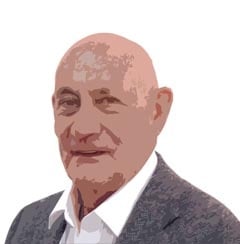David Francis is a hands-on mason who has specialised for many years on the memorial side of the stone industry. He was Technical Advisor to the National Association of Memorial Masons, writing manuals and City & Guilds Qualifications. If you have an issue regarding any aspect of memorial masonry, David is happy to help. Send your questions or comments to David at nss@qmj.co.uk
An expression used when I was taught masonry was ‘best side to London’. From time to time the phrase reoccurs to me when I ask myself “why was that stone fixed that way round”.
Decorative granites with a high mica content such as Blue Pearl must be used in the same orientation (that is, the same way up) if they are going to match. This also applies to some of the particularly light coloured or so-called ‘white’ granites.
These have colour variations between the face and the edge as well as variations across the slab. Customers do not understand this and can be disappointed when they view a memorial from the side.
Importers of memorials certainly should be aware of it. So should the processors of the stone, who should use the material so the memorial makes the most of any variation.
Ordering a memorial through an importer and manufacturer places the onus on the maker to produce a good quality product.
With Blue Pearl and other decoratively figured granites it is important to have a supplier with a good eye for design and colour.
In my business we took great care with matching the slabs. Each one would then be marked with its position and orientation.
One of the worst examples of unmatched material I have seen is not far from the Houses of Parliament, where a wall on an office block is clad in Blue Pearl and the occasional panel has been fixed upside down.
The mica in the granite reflects light and any variations, such as an inverted slab, stick out.
For the memorial mason buying from Asia an understanding of the material is important. Because of the distance and language barrier a high degree of trust is involved.
Some suppliers dispatch the components of a complex memorial without any indication of the orientation of the pieces and it is the fixer who has to work it out.
It is best to completely assemble complex memorials dry before fixing. The fit of all the components can then be checked before taking the memorial to the cemetery. It is fixed dry because, when fixing, water on the surface of the stone can change the colour of it and the way it looks when it is dry. This can make it difficult to orient correctly .
I have also seen memorials that have been sold from samples of the stone alone.
Unless a material is regularly seen in cemeteries, a small, 20mm showroom sample is not enough to give an adequate impression of what a finished memorial will look like.
Apart from variations in colour, which are not obvious in a sample, the slab might differ slightly from one side to the other. The ‘white’ granites are especially prone to variations that are particularly noticeable. A memorial sold in this material that is not what the customer expected can lead to a dissatisfied customer – and dissatisfied customers don’t like paying.
I have arbitrated in many cases where a better understanding of the material and the skills required for working it by the masons would have produced a piece of work to be proud of from the same piece of stone. That would have been a good advertisement. A happy customer will not only be inclined to return to the company that satisfied her needs, she will be inclined to recommend that company to her friends.
There is no more effective advertisement for a business than recommendation – and it’s free!

